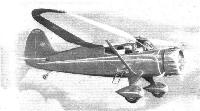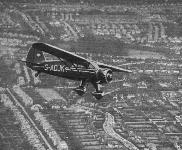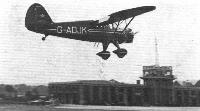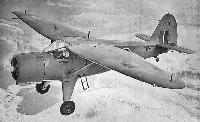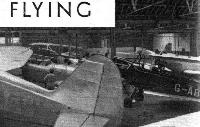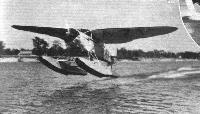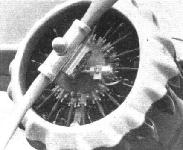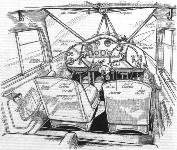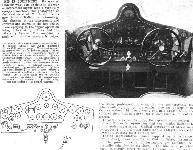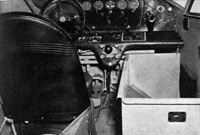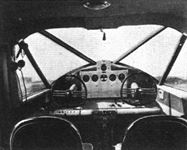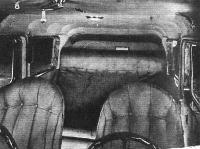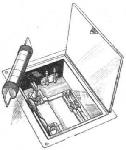
Варианты
- Stinson - Model O - 1933 - США
- Stinson - Reliant - 1933 - США
Stinson Reliant
Самолеты Model R и Model S послужили базой для создания четырехместного кабинного моноплана Reliant. Первоначальный вариант SR Reliant, представленный летом 1933 года, имел в целом такую же конфигурацию, но также выпускался дополнительно как двухпоплавковый гидросамолет. Самолет строился большой серией в различных подвариантах - с различным составом силовой установки.
Самолет SR оснащался двигателем Lycoming R-680 мощностью 215 л.с.; вариант SR-1 имел двигатель R-680-2, a SR-2 - двигатель R-680-7, каждый мощностью 240 л.с.; вариант SR-3 был в целом схож с SR-1, но имел незначительные конструктивные отличия. SR-4 получил звездообразный двигатель Wright R-760-E мощностью 250 л.с., а доработанный вариант SR-5 (1934 год) выпускался в трех модификациях: базовая модель SR-5 с двигателем Lycoming R-680-4 мощностью 225 л.с., а также SR-5B и SR-5C с двигателями R-680-2 мощностью 240 л.с. и R-680-5 мощностью 260 л.с., соответственно.
Однако наиболее массовыми вариантами самолета Reliant стали построенные в количестве 75 экземпляров SR-5A с двигателем R-680-6 мощностью 245 л.с. и SR-5E, строившийся с различными дополнениями и с двигателем R-680-4 мощностью 225 л.с.
Самым же дорогим вариантом Reliant стал SR-5F с двигателями Wright R-760-E мощностью 250 л.с. или R-760-E1 мощностью 285 л.с. В 1935 году компания "Stinson" вывела на рынок усовершенствованный вариант Reliant SR-6. Модификации самолета SR-6 и SR-6B, получившие более мощные двигатели R-680-6 и R-680-5, были пятиместными, a SR-6A с двигателем R-680-4 мощностью 225 л.с. - четырехместным.
Самолет SR-7 Reliant, представленный в 1936 году, имел крыло с переменным сужением и строился в вариантах четырехместного SR-7A с двигателем R-680-4 и пятиместных SR-7B или SR-7C с двигателями R-680-6 и R-680-5, соответственно. Вариант SR-8 Reliant того же года был в целом схож с SR-7, но выпускался в пяти модификациях: SR-8A, SR-8B и SR-8C соответствовали по силовым установкам вариантам SR-7A, SR-7B и SR-7C, но представляли собой четырехместные самолеты, a SR-8D и SR-8E были пятиместными и оснащались двигателями Wright R-760-E1 мощностью 285 л.с. и R-760-E2 мощностью 320 л. с., соответственно. Оба варианта с двигателями Wright предлагались в качестве самолетов общего назначения под обозначениями SR-8DM и SR-8EM.
В 1937 году компания представила самолет SR-9, который имел более существенные отличия в конструкции и выпускался в модификациях SR-9A, SR-9B, SR-9C и SR-9E с такими же силовыми установками, как на соответствующих вариантах SR-8 (по желанию заказчика менялся интерьер - "люкс" или обычный). Дополнением к семейству стал вариант SR-9F с двигателем Pratt & Whitney Wasp Junior мощностью 400 л.с., имевший те же опции по интерьеру.
Последним гражданским Reliant стал SR-10 (1938 год), имевший больше усовершенствований и выпускавшийся с двигателями мощностью от 245 до 450 л. с. Наиболее крупной серией выпускались самолеты SR-10B, SR-10C, SR-10D, SR-10E и SR-10F - всего около 90 машин всех модификаций.
Выпуск гражданских модификаций Reliant прекратился, когда США вступили во Вторую мировую войну, причем Армия США реквизировала для своих нужд 46 гражданских самолетов, которым присвоили обозначения от UC-81A до UC-81N (различные варианты SR-8, SR-9 и SR-10), а также один самолет SR-10F, который получил обозначение XC-81D и использовался для отработки техники захвата планера.
Два SR-5A и два SR-7B были также реквизированы военными и получили обозначения соответственно L-12 и L-12A, плюс к тому по одному Reliant были приобретены Береговой охраной и ВМС США для оценочных испытаний под обозначениями RQ1 и XR3Q-1, соответственно.
В годы войны 500 вновь построенных Reliant в рамках ленд-лиза были поставлены британским ВМС под обозначением AT-19. Самолеты были похожи на SR-10G, оснащались двигателем Lycoming R-680-E1, имели удлиненный фюзеляж и специальное оборудование. Они поступили на вооружение 12 эскадрилий. Кроме того, 15 британских гражданских лайнеров Reliant были реквизированы военными.
ТАКТИКО-ТЕХНИЧЕСКИЕ ХАРАКТЕРИСТИКИ
Stinson Reliant SR-5A
Тип: 4-местный кабинный моноплан
Силовая установка: один звездообразный ПД Lycoming R-680-6 мощностью 245 л. с. (183 кВт)
Летные характеристики: максимальная скорость 217 км/ч; практический потолок 4725 м; максимальная дальность 1038 км
Масса: пустого 1055 кг; максимальная взлетная 1576 кг
Размеры: размах крыла 12,50 м; длина 8,31 м; высота 2,57 м; площадь крыла 21,37 м!
Описание:
- Stinson Reliant
- Flight, October 1935
FOR the FASTIDIOUS - Flight, April 1936
MODERN LIGHT AIRCRAFT REVIEW - Flight, July 1939
THE NEWEST RELIANT - Flight, September 1939
To-day's Light Aeroplanes
Фотографии
-
Мировая Авиация 222
Регистрационный номер: G-BUCH Гражданские Stinson Reliant создавались на базе военного варианта и отлично продавались в 1940-е годы, особенно в США. Эта машина выпущена в 1942 году, имеет британскую регистрацию и в 2011 году была в летной годности.
-
Jane's All the World Aircraft 1980 / Encyclopedia of Aviation - Aircraft A-Z - v5
Stinson SR-9C Reliant.
-
Aeroplane Monthly 1999-12 / M.Oakey, T.Harmsworth - News
Регистрационный номер: SE-BZP Seen stopping for fuel at Old Buckenham, Norfolk, Stinson Reliant SE-BZP is now Lincolnshire-based.
-
Air Pictorial 1956-06 / Air Pictorial's photo-review
Регистрационный номер: N13847 Beautifully-preserved, pre-war Stinson Model SR-5 (c/n. 9221) N13847 seen in front of a Canadian Grumman Mallard, CF-HAV.
-
Air Pictorial 1957-11 / Air Pictorial's photo-review
Регистрационный номер: CF-ILG MONTREAL-BASED. An ex-U.S.A.A.F. Stinson V-77 Reliant (CF-ILG; AC-41-20009) four-seater at Cartierville Airport.
-
Aeroplane Monthly 1989-05 / Personal album. Civil
Регистрационный номер: NC2285 Stinson SR-9 NC2285 at Springfield Airport. The 1937 version of thus well-tried five-seater came in either De Luxe ("D") series or Multi-Purpose (“M”), the former for the private owner and sportsman pilot and the latter for general transport duties. Variants were powered by the Wright Whirlwind (285-320 h.p.), the 450 h.p. Pratt & Whitney Wasp Junior, and the 245 h.p. Lycoming nine-cylinder R-680-D6 engine. Fitted with the Lycoming, the SR-9BD cruised at around 140 m.p.h. and had a range of 400 miles.
-
Flight 1937-05 / Flight Advertisements
STINSON RELIANT 9FD. 450 h.p. Wright Whirlwind or Pratt and Witney Wasp. Cruising speed 178 m.p.h. Climb 1,500 feet per minute. Range 690 miles. Useful load 1,565 lbs.
-
Aeroplane Monthly 1989-06 / Personal album. Civil
Регистрационный номер: NC13857 Stinson SR.5A NC13857 at Heston. The 1934 Stinson Reliant model was the most popular of the series. The four-seater was powered by a nine-cylinder Lycoming R-6806. About 75 were built at the Wayne, Michigan Stinson Aircraft plant.
-
Flight 1934-05 / Flight
Регистрационный номер: NC13834 THE STINSON "RELIANT": This is the 1934 model, which, powered with the Lycoming 225 h.p. engine, carries four passengers in an unusually comfortable cabin. The basic design is similar to that of previous Stinson machines, examples of which have been seen in this country. The cruising speed is 115 m.p.h.
-
Jane's All the World Aircraft 1938 / 03 - All the world's aeroplanes
Регистрационный номер: NC17147 The Stinson "Reliant" Model SR-10ED Five-seat Cabin Monoplane (320 h.p. Wright "Whirlwind" engine).
-
Jane's All the World Aircraft 1946 / 03 - All the world's aeroplanes
Регистрационный номер: NC21132 Cleaner lines for the new Reliant; notice the smooth engine cowling. Stinsons now produce a lightweight, known as the 105.
The commercial Stinson SR-10 Reliant Four/five-seat Cabin Monoplane. -
Air Pictorial 1958-10 / Spotter's Notebook
Регистрационный номер: NX12132 The one and only diesel-powered Stinson.
-
Flight 1936-02 / Flight Advertisements
BEAUTY TREATMENT. The new type of wing and general cleaning-up has vastly improved the appearance of the Stinson Reliant. This view is of the latest 1936 model. With a cruising speed of 140 m.p.h. and four comfortable seats it is an attractive proposition. The engine is a nine-cylinder Lycoming of 225 h.p.
-
Air Pictorial 1988-02 / N.Mercer - USAir - Stretching across the Continent
Регистрационный номер: NC22085 An All American Aviation Stinson SR-10C, painted all red and believed to be NC22085, demonstrates Dr. Adams' mail collection system
-
Flight 1939-09 / Flight
Регистрационный номер: NC21109 A standard Stinson Reliant of All-American Aviation, Inc., picking up a mail container at a small town which has no aerodrome
-
Aeroplane Monthly 1991-03 / M.Fife - The Great Air Race
Регистрационный номер: G-ABGK [2] This Stinson Reliant was used to represent the Lockheed Vega DL-1A G-ABGK, named Puck and flown in the race by Jimmy Woods and Don Bennett, representing Australia. The Vega got as far as Aleppo, where it crashed on landing following an undercarriage collapse.
-
Aeroplane Monthly 1991-03 / M.Fife - The Great Air Race
Регистрационный номер: G-ABGK [2] A reconstruction of the start of the race. Seen here at Laverton are the taxying replica of D.H.88 Comet G-ACSS, “DC-2" PH-AJU, the static replica Comet “G-ACSP" and a Stinson Reliant doubling as Lockheed Vega G-ABGK. Nearest the camera are another Reliant and Airworld's Cessna 195 VH-AVZ.
Другие самолёты на фотографии: Cessna 190 / 195 Businessliner - США - 1947De Havilland Comet / D.H.88 - Великобритания - 1934Douglas DC-3 / C-47 Skytrain/С-53 Skytrooper / Dakota - США - 1935
-
Flight 1935-10 / Flight
Регистрационный номер: G-ADJK [3] The new Reliant flying near Croydon: This picture was taken by a Flight photographer from Mr. Leslie Irvin's own Stinson.
-
Flight 1935-10 / Flight
Регистрационный номер: G-ADJK [3] The Reliant coming in to land at Croydon with the pneumatically operated flaps, which are the most effective of air brakes, in the "down" position.
-
Flight 1935-10 / Flight
Регистрационный номер: G-ADJK [3] RELIANT: The latest Stinson Reliant photographed outside Rollason's shops at Croydon soon after it had been assembled for Brian Allen Aviation, who are the sole distributors in this country. This new model has pneumatically operated flaps and a Smith v.p. airscrew as well as improved internal fittings
-
Aeroplane Monthly 1988-01 / Personal album. Civil
Регистрационный номер: G-AELU, X9596 Imported by Brian Allen Aviation, Stinson SR-8 Reliant G-AELU was registered in November 1936 and operated with Acropolis Ltd from Heston. After impressment into RAF service as X9596 in May 1940 it was lost following a take-off accident from Woburn Abbey on July 13, 1944.
-
Flight 1937-05 / Flight
Регистрационный номер: G-AEVX, G-AEVY -
Flight 1937-09 / Flight
Регистрационный номер: G-AEXW BUENOS FAKING. The Brooklands clubhouse after Warner Bros, had adapted it to film requirements as a Spanish Airport Building. The windsock must be an international one!
-
Aeroplane Monthly 1991-02 / Personal album. Civil
Регистрационный номер: G-AEYZ, X8521 The Hon C. J. Wynn’s Stinson SR-9 Reliant G-AEYZ, often kept at Doncaster and flown by Cecil Bebb on behalf of Olley Air Service Ltd. It was impressed as X8521 in February 1940, but its RAF career was short. On November 20 that year it suffered engine failure over the Orkneys and was damaged beyond repair after hitting a stone wall at Sunday, near Start Point. G-AEYZ was powered by a 320 h.p. Wright Whirlwind R-760-E1 radial engine.
-
Aeroplane Monthly 1988-01 / Personal album. Civil
Регистрационный номер: G-AFBI, W5701 Stinson SR-9D Reliant G-AFBI was owned by Robert Blackburn and used by him for Blackburn Aircraft business. The SR-9D was powered by a 320 h.p. Wright Whirlwind R-760-E1 radial engine. The Reliant was one of a dozen or so impressed into RAF service, becoming W5701 in December 1939. In December 1944 it was put into storage until April 1946, when it was burnt.
-
Aeroplane Monthly 1988-01 / Personal album. Civil
Регистрационный номер: G-AFRS [2], W7978 [2] The Stinson SR-10C Reliant was distinguished from its sisters by way of the smooth unblistered cowling enclosing its 250 h.p. Lycoming R-680-D5 radial engine. Registered in July 1939, G-AFRS was impressed into the RAF in February the following year and became W7978. Its career ended on April 28, 1942 when it crashed into a field near Mill Hill in North London, following engine failure while taking off from nearby RAF Hendon.
-
Flight 1939-07 / Flight
Регистрационный номер: G-AFRS [2], W7978 [2] The 1939 model no longer has the characteristic Stinson cowling.
-
Air Pictorial 1956-03 / Special correspondent - Strangers in the Camp
Регистрационный номер: G-AFVT [3] The magnIficent condItion of Fairey Aviation's Stinson Reliant is evident in this photograph.
-
Air-Britain Archive 1986-02
Регистрационный номер: G-AFVT [3] Stinson SR-10C Reliant G-AFVT remained with Fairey Aviation until 1960 and was converted to SR-10J towards the end of its twenty years service. It was sold to J.D.Habin and photographed by the Editor at Eastleigh on 28.3.61.
-
Air-Britain Archive 1987-04
Регистрационный номер: G-AFVT [3] Faireys were major suppliers of Fleet Air Arm aircraft, so their communications Reliant G-AFVT often visited the FAA HQ at Lee on Solent during the war years. Appropriately a Fairey Swordfish sits in the background.
Другие самолёты на фотографии: Fairey Swordfish - Великобритания - 1934
-
Air Pictorial 1957-03 / Air Pictorial's photo-review
Регистрационный номер: CF-HPE, NC17194, UC-BIE A beautifully maintained Stinson SR-9F Reliant four/five-seater (c/n. 5707, ex NC17194) - one of four impressed by U.S.A.A.F. in 1942 as UC-BIE. Power: 450-h.p. P. & W. R-9B5-AN-1. Built, summer 1937.
-
Авиация и Время 1999-02 / А.Котлобовский - Малые ВВС в большой войне. ВВС Словакии на Восточном фронте в 1941 году /Аэроархив/ (2)
Регистрационный номер: OK-ATZ Связной самолет Stinson Reliant, которым пользовался министр обороны Словакии
-
Jane's All the World Aircraft 1938 / 01 - The progress of the world in civil aviation during the year 1937-38
Регистрационный номер: OO-APM [Stinson SR.6 Reliant] The Airport of Steene (Ostende).
-
Aeroplane Monthly 1991-03 / M.Fife - The Great Air Race
Регистрационный номер: VH-ISR Stinson Reliant VH-ISR in minimal disguise, merely with the VH painted out and G substituted - hence the odd-looking registration, which seems to need an extra letter. This Reliant was not masquerading as any particular MacRobertson Race participant, but, like Cessna 195 VH-AVZ, was just acting as a period "extra”. In real life VH-ISR arrived in Australia in December 1989 for private owner Rob Black; CAA paperwork prevented it flying until the following April.
-
Aeroplane Monthly 1988-03 / Stinson SR-8C VH-CWM /Preservation Profile/
Регистрационный номер: VH-UXL [5], A38-1 [5], VH-CWM [5] Between October 1936 and September 1939 VH-UXL was based at Essendon, Victoria.
-
Aeroplane Monthly 1988-12 / M.Oakey - Grapevine
Регистрационный номер: VH-CWM [5], A38-1 [5], VH-UXL [5] Based at Wangaratta, Victoria, Australia, Airworld Stinson Reliant VH-CWM has recently reappeared in a gleaming new red and white colour scheme, representative of the 1936-41 period when it was registered VH-UXL.
-
Aeroplane Monthly 1988-03 / Stinson SR-8C VH-CWM /Preservation Profile/
Регистрационный номер: VH-CWM [5], A38-1 [5], VH-UXL [5] As VH-CWM at Bankstown, NSW in August 1964, the year in which it took part in the Ansett Brisbane - Adelaide Air Race.
-
Aeroplane Monthly 1988-03 / Stinson SR-8C VH-CWM /Preservation Profile/
Регистрационный номер: VH-CWM [5], A38-1 [5], VH-UXL [5] -
Air-Britain Archive 1987-02
Регистрационный номер: ZK-BDV James Aviation had imported Stinson Reliant ZK-BDV for the Rotorua tourist trade.
-
Aeroplane Monthly 1988-03 / Stinson SR-8C VH-CWM /Preservation Profile/
Регистрационный номер: A38-1 [5], VH-CWM [5], VH-UXL [5] The same aircraft after impressment into the RAAF, when it became A38-1. As such it served with No 2 Communications Flight all of its service life.
-
Aeroplane Monthly 1982-05 / G.Todd - Rover's Return
Регистрационный номер: FK878 [2] Royal Navy Stinson Reliant FK878, similar to the Reliant flown by the author, at the ATA Pageant at White Waltham in September, 1945.
-
Aeroplane Monthly 1985-02 / C.Zichy - Twenty six candles
Регистрационный номер: FK878 [2] A Royal Navy Stinson Reliant I, similar to the one referred to in this article, photographed at the ATA Pageant at White Waltham on September 29, 1945.
-
Jane's All the World Aircraft 1946 / 03 - All the world's aeroplanes
The Stinson AT-19 Reliant Navigational Training Monoplane (290 h.p. Lycoming R-680-13 engine).
-
Мировая Авиация 241
Регистрационный номер: FK815 Stinson Reliant поставлялись британским ВМС по ленд-лизу с 1943 года. Они использовались для подготовки штурманов и в качестве связных в составе 26-ти эскадрилий и подразделений авиации ВМС.
-
Aeroplane Monthly 1990-01 / E.Shackleton - Confederate Air Force update
Регистрационный номер: FK810, N60634 A delightful study of Stinson Reliant FK810/N60634, operated by the Confederate Air Force’s Carolinas Wing.
-
Aeroplane Monthly 1987-12
Регистрационный номер: N65846 This Santa Monica-based Stinson V-77, N65846, painted in World War Two Royal Navy colours, actually served with the RN as part of the Lend-Lease agreement.
-
Flight 1938-04 / Flight
MIDLANDS CENTRE: The terminal building and hangar at the new Wolverhampton aerodrome - with a small portion of Mr. J. R. Bryan’s Reliant in the right foreground. The Midland Aero Club are providing the club flying facilities there, while Boulton Paul already give a manufacturing atmosphere. The latter’s works, incidentally, make an excellent landmark when the aerodrome is being approached in poor visibility.
-
Flight 1937-09 / Flight
"... which, in view of age, type and original cost, was in the best condition."
-
Flight 1937-10 / Flight
THE ILL WIND: A corner of Rollason's hangar at Croydon. In the foreground is a Stinson Reliant, with the little Latvian V.E.F. J.12 behind it and the South African Junkers Junior on the right. One of I.A.F.'s Curtiss Condor freighters can be seen in the far distance.
Другие самолёты на фотографии: Curtiss Condor 18 - США - 1929Irbitis, VEF I-11 / I-12 / I-17 - Латвия - 1936Junkers A 50 Junior - Германия - 1929
-
Aeroplane Monthly 1991-06 / M.Oakey - Grapevine
Регистрационный номер: N9570H The scene in Duxford’s Superhangar just before the Brooks auction on April 15, 1991. In the foreground are Grumman Avenger N6827C and Stinson Reliant N9570H.
Другие самолёты на фотографии: Grumman TBF/TBM Avenger - США - 1941
-
Flight 1936-05 / Flight
Регистрационный номер: CF-AYW [3] The Stinson Reliant (Lycoming engine) as an air ambulance;
-
Flight 1937-01 / Flight
Регистрационный номер: CF-AYW [3] The Stinson Reliant, handled by Brian Allen Aviation
-
Flight 1936-05 / Flight
Регистрационный номер: CF-AYW [3] Edo floats can be specified for the new Stinson which is available in a number of different forms for specialised purposes.
-
Flight 1938-01 / Flight
Регистрационный номер: CF-BEQ SEAPLANE CONVERSION: A Stinson SR-9D Reliant seaplane used in Canada by the Imperial Oil Company. The extra fin below the fuselage - to balance the effect of the floats which provide excessive side area ahead of the c.g. - is a noteworthy modification to the standard version of the machine. The actual and necessary size of the floats explains some of the difficulties involved in any conversion.
-
Jane's All the World Aircraft 1938 / 03 - All the world's aeroplanes
Регистрационный номер: CF-AZI [2] The Stinson "Reliant" Five-seat Cabin Seaplane (245 h.p. Lycoming engine).
-
Flight 1937-04 / Flight
Регистрационный номер: CF-AZI [2] The American private-owner type equipped with Edo floats: the latest Stinson Reliant
-
Air Enthusiast 1997-03 / B.Elliott - Bears in the Air
Регистрационный номер: NC21147 Stinson SR-10K floatplane NC21147, with the NYPD from July 1939 to March 1945.
-
Flight 1937-05 / Flight
The latest Lycoming-Smith electrically controlled airscrew is now a standard feature of all Reliants; its method of control is both interesting and Ingenious. This Flight photograph also shows the new type of engine cowling.
-
Flight 1935-10 / Flight
Comfort and convenience have been carefully studied in the planning of the Reliant's cabin. The instrument panel mounting is shockproof.
-
Flight 1937-07 / Flight
THIS IS EQUIPMENT: By way of showing what can be done in the way of instrument layout with a very fully equipped machine, this photograph of the dashboard of Mr. Leslie Irvin's new Stinson Reliant is interesting. The placings of the instruments and controls are shown in the key below, those applying to the engine operation being indicated by letters and the others by figures.
-
Flight 1939-09 / Flight
The mail bin on the right-hand side of the cockpit has a capacity of 250 lb. The aeroplanes are provided with two-way radio.
-
Flight 1937-05 / Flight
Some idea of the car-like appearance of the interior of the Reliant can be gathered from this "peep" through the door of the specially equipped Wright-engined model purchased by Mr. Bryans.
-
Flight 1939-04 / Flight
Inside the latest Stinson Reliant: The neatness of the instrument and control layout is noteworthy; presumably the large panel can take other instruments, such as those of the free gyro type, when these are ordered. The cowling of the latest Reliant has, incidentally, been changed both to improve the lines and to increase the accessibility.
-
Flight 1937-03 / Flight
"Saloon car" interior appearance is the aim in the latest Stinson, another American type with British concessionaire.
-
Aeroplane Monthly 1989-02 / Personal album. Civil
Регистрационный номер: G-AEFY, W7979 Two photographs taken at Hanworth after a taxying collision between Blackburn B-2 G-ACEO and a Stinson SR-7B Reliant, almost certainly L. C. Desoutter's G-AEFY. The incident probably occurred in 1937 and both aircraft were subsequently repaired. In November 1939 the B-2 was re-engined with a Cirrus Major and in February 1942 was given to the Cumberland Air Training Corps as 2899M. The Stinson was impressed into RAF service as W7979.
Другие самолёты на фотографии: Blackburn Bluebird / L.1 - Великобритания - 1924
-
Flight 1935-10 / Flight
A master fuse is placed so that it can be immediately reached while in flight and its removal cuts out the very full electrical equipment of the Reliant.
-
Jane's All the World Aircraft 1946 / 03 - All the world's aeroplanes
The Stinson AT-19 Reliant Navigational Trainer.
- Фотографии














